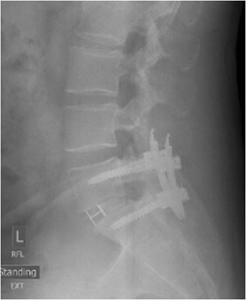Spine fusion procedures are performed to correct deformities of the spine and stabilize it. In many cases, it is combined with surgical decompression.
 DISORDERS TREATED WITH SPINE FUSION
DISORDERS TREATED WITH SPINE FUSION
- Scoliosis
- Spondylolisthesis
- Spondyloarthritis
- Spinal Stenosis (in combination with decompression techniques)
TECHNIQUES
- Anterior Lumbar Interbody Fusion (ALIF)
- Direct Lateral Interbody Fusion (DLIF / XLIF)
- Transforaminal Lumbar Interbody Fusion (TLIF)
- Trans-sacral Fusion at L5-S1
- ALIF . Anterior (transabdominal) approach to the spine. It is often combined with posterior spine fusion for better stabilization of the spine.
- DLIF. Approach to the spine from the side of the body. The surgical instruments pass through the psoas muscle, which is a long muscle extending bilaterally to the spine.
- TLIF . Approach to both sides of the intervertebral disc through the intervertebral foramina, which are the exit points from which the nerves get out of the spinal canal. A titanium cage is placed between the vertebral bodies. Screws and bone grafts are fixed on the vertebral pedicles in order to better stabilize the posterior part of the spine. With the TLIF technique, the spine is fused anteriorly and posteriorly.
- TRANS-SACRAL FUSION. Procedure at level L5 – S1 of the lumbar spine approaching through the sacrum. The intervertebral disc is removed and grafts are placed. Screws are often applied additionally to provide further stabilization of the spine.













